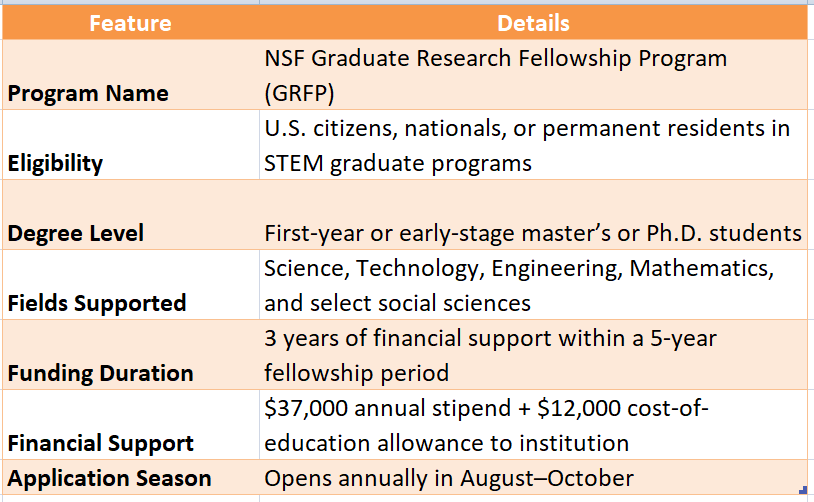The National Science Foundation Graduate Fellowship is a valuable opportunity for students in science, technology, engineering, and mathematics (STEM). It offers not just financial support but also access to a professional network and resources that can enhance your academic experience.
Benefits of the NSF Graduate Fellowship
- Financial Support: Includes a stipend and tuition coverage.
- Research Opportunities: Access to innovative research projects.
- Networking: Connect with peers and professionals in your field.
Qualifying for the NSF Graduate Fellowship
To qualify, applicants must show academic excellence and research commitment. Key steps include:
- Eligibility: Must be a U.S. citizen or permanent resident.
- Application: Submit a comprehensive research proposal.
- Recommendations: Obtain strong letters from mentors or professors.
Additionally, consider the Paul & Daisy Soros Fellowship for New Americans, which supports immigrants in graduate studies, providing another avenue for funding alongside the NSF fellowship.
Contact Now to Pursue Your Dream Degree From Your Nearest College
Who is Eligible for the NSF Graduate Fellowship?

The National Science Foundation Graduate Fellowship is a prestigious opportunity for students in science, technology, engineering, and mathematics (STEM). Knowing who qualifies is essential, as it opens doors to funding and resources that enhance your academic journey.
To qualify, applicants must meet specific criteria:
- Citizenship: You must be a U.S. citizen, national, or permanent resident.
- Field of Study: Your research should align with NSF-supported fields, primarily in STEM.
- Academic Standing: You should be enrolled in or planning to enroll in a graduate program.
- Previous Funding: If you’ve received other grants for graduate programs, such as the Paul & Daisy Soros Fellowship for New Americans, it may affect your eligibility, so check the guidelines carefully.
By meeting these criteria, you can secure funding for your graduate studies. The NSF Graduate Fellowship not only provides financial support but also connects you with a community of scholars dedicated to advancing knowledge in their fields.
Key Benefits of the NSF Graduate Fellowship
The National Science Foundation Graduate Fellowship is a prestigious opportunity for students in science, technology, engineering, and mathematics (STEM). It provides not only financial support but also access to a network of scholars and professionals, making it a valuable option for your academic journey.
- Financial Support: The fellowship offers substantial funding for tuition and living expenses, reducing financial stress and allowing you to focus on your studies.
- Research Opportunities: Recipients can engage in unique research projects and collaborations, enriching their academic experience.
- Networking: Joining the NSF community connects you with talented individuals and professionals, potentially leading to future job opportunities.
- Grants for Graduate Programs: The fellowship can serve as a stepping stone to other grants, such as the Paul & Daisy Soros Fellowship for New Americans, further supporting your educational goals.
In summary, the NSF Graduate Fellowship is more than financial aid; it’s a gateway to resources and connections that can enhance your graduate experience. Consider how these benefits align with your academic and career aspirations.
How to Prepare Your NSF Graduate Fellowship Application
Applying for the National Science Foundation Graduate Fellowship can significantly enhance your academic journey. This prestigious fellowship offers financial support and opens doors to valuable research opportunities. Knowing how to prepare your application is essential for success.
Understand the Requirements
Begin by reviewing the eligibility criteria. The NSF Graduate Fellowship targets students pursuing research-based master’s or doctoral degrees in STEM fields. Ensure you meet these requirements before starting your application.
Gather Your Materials
Collect all necessary documents, including transcripts, letters of recommendation, and a strong personal statement. Your personal statement should convey your passion for your field and how the fellowship will help you achieve your goals.
Highlight Your Achievements
In your application, focus on your academic accomplishments and relevant research experience. If you’re considering other funding options, like the Paul & Daisy Soros Fellowship for New Americans, mention how these grants for graduate programs can enhance your NSF application. This demonstrates your proactive approach!
What Are the Selection Criteria for the NSF Fellowship?
The National Science Foundation Graduate Fellowship is a prestigious opportunity for students in STEM fields. Qualifying for this fellowship can lead to valuable research and funding opportunities. Here are the key selection criteria to help you stand out!
Academic Excellence
A strong academic record is essential for the NSF Graduate Fellowship. This includes maintaining high grades and a solid GPA. Showcasing your commitment through relevant research or projects can enhance your application.
Research Potential
The NSF seeks candidates with promising research potential. Having experience in labs or projects related to your field is crucial. Highlighting your research contributions can significantly strengthen your application, as the fellowship aims to nurture future STEM leaders.
Personal Statement
Your personal statement is vital. It should convey your passion for science and outline your career goals. Connect your experiences to the NSF’s mission, and consider mentioning other grants for graduate programs, such as the Paul & Daisy Soros Fellowship for New Americans, to showcase your diverse interests.
Tips for Writing a Winning NSF Graduate Fellowship Proposal
The National Science Foundation Graduate Fellowship is a highly regarded opportunity for students in science, technology, engineering, and mathematics (STEM). Knowing how to qualify for this fellowship is crucial for aspiring graduate students, as it can lead to significant funding and research opportunities.
Know Your Audience
When writing your proposal, keep in mind that reviewers seek passion and clarity. They want to see how your research aligns with the NSF’s goals.
Highlight Your Unique Qualities
Emphasize what makes you unique. If you’re a first-generation college student, mention how the Paul & Daisy Soros Fellowship for New Americans can enhance your experience.
Be Clear and Concise
Use straightforward language and avoid jargon. Organize your proposal with headings and bullet points to highlight key insights, such as your research goals and their potential impact.
Seek Feedback
Before submitting, seek feedback from mentors or peers. Their insights can strengthen your proposal, making it more competitive among other grants for graduate programs.
Common Mistakes to Avoid When Applying for the NSF Fellowship
Applying for the National Science Foundation Graduate Fellowship can be a game-changer for your academic journey. However, many applicants stumble due to common mistakes. Understanding what to avoid can significantly enhance your chances of securing this prestigious funding, which supports promising graduate students in science and engineering fields.
- Ignoring Eligibility Requirements: Always check if you meet the criteria. The NSF Graduate Fellowship is competitive, and not meeting the basic requirements can lead to automatic disqualification.
- Neglecting Personal Statements: Your personal statement is your chance to shine. Avoid generic responses; instead, share your unique story and how the fellowship aligns with your goals. Remember, this is your moment to connect with the reviewers!
- Overlooking Other Opportunities: While the NSF Fellowship is fantastic, don’t forget about other grants for graduate programs, like the Paul & Daisy Soros Fellowship for New Americans. Exploring multiple funding sources can increase your chances of success.
Contact Now to Pursue Your Dream Degree From Your Nearest College
How the NSF Graduate Fellowship Supports Your Research Goals
The National Science Foundation Graduate Fellowship is a fantastic opportunity for students pursuing advanced degrees in science, technology, engineering, and mathematics (STEM). This fellowship not only provides financial support but also opens doors to valuable research experiences. Understanding how to qualify for this fellowship can significantly impact your academic journey and future career.
Key Benefits of the NSF Graduate Fellowship
- Financial Support: The fellowship offers substantial funding, which can cover tuition and living expenses.
- Research Opportunities: Recipients gain access to unique research projects and mentorship from leading experts in their fields.
- Networking: Joining a community of scholars can lead to collaborations and new ideas.
Additionally, the NSF Graduate Fellowship is often compared to other grants for graduate programs, like the Paul & Daisy Soros Fellowship for New Americans. Both provide essential support, but the NSF focuses specifically on STEM fields, making it a perfect fit for aspiring scientists and engineers. By applying for these fellowships, you can enhance your research goals and make a meaningful impact in your field.
Exploring the Impact of the NSF Graduate Fellowship on Your Career
The National Science Foundation Graduate Fellowship is a prestigious opportunity for students in science, technology, engineering, and mathematics (STEM). This fellowship can greatly enhance your academic journey and career prospects by providing financial support, allowing you to focus on research without the stress of student debt.
What Does the NSF Graduate Fellowship Offer?
- Financial Support: Generous stipends and tuition coverage.
- Research Opportunities: Access to cutting-edge research projects.
- Networking: Connect with a community of scholars and professionals.
How to Qualify for the NSF Graduate Fellowship
To qualify, demonstrate academic excellence and research commitment. Key steps include:
- Eligibility: Meet citizenship and enrollment criteria.
- Application: Submit a strong application showcasing your achievements.
- Recommendations: Obtain strong letters from mentors or professors.
Additionally, consider the Paul & Daisy Soros Fellowship for New Americans, which supports immigrants and can complement your NSF fellowship, broadening your financial support for graduate programs.
How CollegeDegree.Education Can Help You Navigate the NSF Fellowship Application Process
Navigating graduate fellowships, particularly the National Science Foundation Graduate Fellowship, can be daunting. This prestigious award supports students in STEM fields, and knowing how to qualify can lead to valuable opportunities and funding for your studies.
Key Steps to Qualify
- Understand Eligibility: You must be a U.S. citizen or permanent resident enrolled in a STEM graduate program.
- Prepare Your Application: Include a personal statement, research proposal, and letters of recommendation to showcase your potential.
- Explore Other Grants: Consider fellowships like the Paul & Daisy Soros Fellowship for New Americans, which aids immigrants and their children in graduate education.
With proper guidance, applying for grants for graduate programs becomes manageable. CollegeDegree.Education provides resources, tips, and expert advice to help you create a strong application. Each fellowship can be a crucial step toward achieving your academic and professional goals!
Contact Now to Pursue Your Dream Degree From Your Nearest College
FAQs
1. What is the NSF Graduate Research Fellowship Program (GRFP)?
The NSF GRFP is a prestigious fellowship that supports outstanding graduate students in science, technology, engineering, and mathematics (STEM) disciplines who are pursuing research-based master’s and doctoral degrees.
2. Who is eligible to apply for the NSF GRFP?
Applicants must be:
-
U.S. citizens, nationals, or permanent residents
-
Early in their graduate studies (typically first or second year)
-
Enrolled in or planning to enroll in an eligible graduate program in a STEM field
3. What fields of study are supported by the GRFP?
The GRFP supports a wide range of STEM fields, including engineering, life sciences, computer science, chemistry, physics, mathematics, psychology, and social sciences. Clinical or practice-oriented fields are not eligible.
4. What does the fellowship provide?
The fellowship includes:
-
A $37,000 annual stipend (as of recent years)
-
A $16,000 cost-of-education allowance paid to the institution
-
Access to professional development resources and opportunities
5. How long does the fellowship last?
The GRFP provides up to three years of support within a five-year fellowship period.


